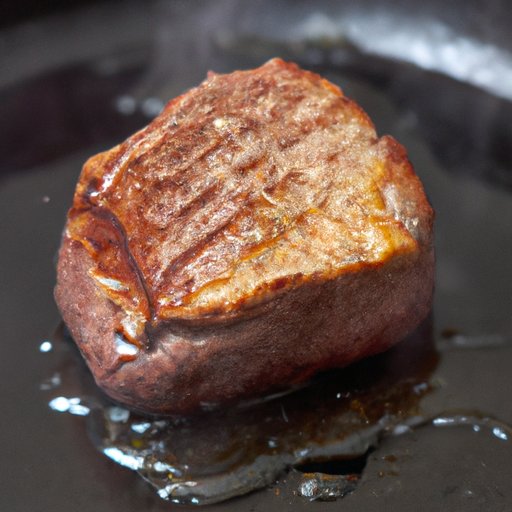
I. Introduction
Pan searing steak can seem a daunting task, even for seasoned home cooks. However, with the right guidance, anyone can achieve a restaurant-quality sear at home. In this article, we will guide you through the process, step-by-step, providing tips and tricks along the way.
II. Step-by-Step Guide
Selecting the right cut of steak
When it comes to pan searing steak, choosing the right cut is essential. Look for steaks that are at least 1-inch thick, such as rib-eye, New York strip, or filet mignon. These cuts have enough marbling to create a flavorful crust when seared.
Seasoning the steak
Before searing, season the steak generously with salt and pepper on both sides. You can also add other seasonings, such as garlic powder or rosemary, to enhance the flavor.
Preparing the pan and oil
Preheat a heavy-bottomed skillet over medium-high heat. Add a high smoke point oil, such as vegetable or canola oil, to the pan, and swirl to coat. Wait until the oil is shimmering before adding the steak.
Searing the steak
Place the steak in the pan. Don’t move it for the first 2-3 minutes to allow for a crust to form. After 2-3 minutes, flip the steak and repeat on the other side. Use a meat thermometer to check for doneness. A temperature of 130°F for medium-rare or 135°F for medium is recommended.
Resting the steak
After searing, remove the steak from the pan and let it rest for 5-10 minutes on a cutting board. This allows the juices to distribute evenly throughout the steak, resulting in a juicy and flavorful bite.
Slicing and serving the steak
After resting, slice the steak against the grain to ensure tenderness. Serve immediately and enjoy your perfectly seared steak!
III. Tips and Tricks
Choosing the right thickness of steak
Cuts of steak that are at least 1-inch thick are best for pan-searing as they result in a better sear and cook more evenly.
Importance of seasoning and resting
Seasoning the steak before cooking enhances the flavor, while letting the steak rest after searing allows for even distribution of juices, resulting in a juicy and flavorful steak.
Choosing the right oil for searing
High smoke point oils, such as vegetable or canola oil, are best for pan-searing as they don’t burn easily, resulting in a better sear.
Determining the correct level of heat
Medium-high heat is recommended for pan-searing steak as it creates a nice sear without burning the steak.
Achieving a perfect sear
To achieve a perfect sear, make sure the pan is hot and the oil is shimmering before adding the steak. Don’t overcrowd the pan, as this will result in steaming rather than searing.
IV. Top Ingredients
Essential ingredients for pan searing steak
The essential ingredients for pan-searing steak are quality, thick-cut steak, salt, pepper, and high smoke point oil. Other seasonings can be added based on personal preference.
Where to buy these ingredients
Quality steak can be found at local butcher shops or specialty grocery stores. Salt, pepper, and oil can be found at any grocery store.
What brands to look for
For quality steak, look for brands such as USDA Prime or Wagyu beef. When it comes to oil, brands such as Bertolli or Filippo Berio are good options.
V. Equipment
Choosing the right pan for searing
A heavy-bottomed skillet, preferably cast iron or stainless steel, is best for pan-searing steak as it retains heat and distributes it evenly.
Recommended spatulas and tongs
A metal spatula and tongs are best for flipping the steak. Make sure they are long enough to prevent burning your hands.
The importance of a meat thermometer
A meat thermometer is essential for ensuring the steak is cooked to the desired level of doneness.
VI. Seasonings
Different seasoning blends for steak
Steak can be seasoned with a variety of blends, such as Montreal steak seasoning or steak rubs. Experiment with different blends to find your preferred flavor.
Rubs, marinades and sauces to enhance flavor
Rubs, marinades, and sauces can be used to enhance the flavor of your steak. Try a simple garlic and herb butter or a classic chimichurri sauce.
The right amount of seasoning to use
A good rule of thumb is to use 1 teaspoon of salt and ½ teaspoon of pepper per pound of steak. Adjust the amount based on personal preference.
VII. Common Mistakes
Overcooking the steak
Overcooking the steak can result in a tough and dry texture. Use a meat thermometer to ensure the steak is cooked to the desired level of doneness.
Not letting the steak rest
Not letting the steak rest after searing can result in dryness and a lack of flavor. Letting the steak rest for 5-10 minutes allows the juices to distribute evenly throughout the steak.
Using the wrong oil or pan
The wrong oil or pan can result in uneven cooking and a poor sear. Use a high smoke point oil and a heavy-bottomed skillet for best results.
Not using a meat thermometer
Not using a meat thermometer can result in an overcooked or undercooked steak. Invest in a good quality meat thermometer for best results.
VIII. Recipe Variations
Steak au Poivre
Coat the steak in crushed peppercorns before searing, and serve with a classic French pan sauce made with brandy and cream.
Different sauce ideas
Try serving your steak with a flavorful sauce, such as bordelaise, mushroom gravy, or béarnaise.
How to add flavor with infused butter
Create a compound butter infused with herbs, garlic, or spices to add extra flavor to your steak. Simply soften butter and mix in desired ingredients, then chill until firm.
IX. Conclusion
Pan searing steak is a simple process that anyone can master. By following these step-by-step instructions and incorporating our tips and tricks, you can achieve a perfect sear every time. Don’t be afraid to experiment with different seasonings and sauces to find your preferred flavor profile.





